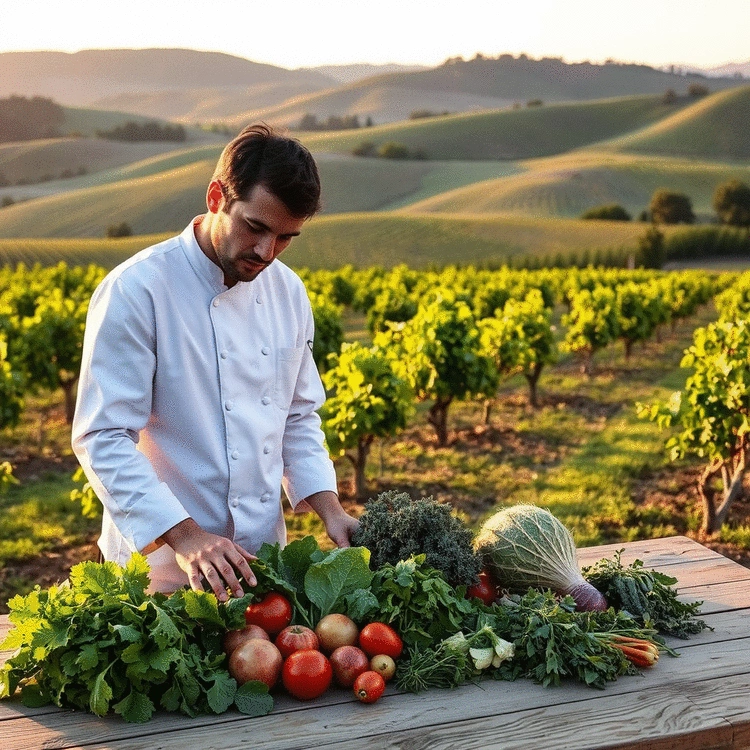
- Restaurant Reviews
- Mar 24
2025-08-24
What if every meal you enjoyed could help save the planet? In Napa Valley, sustainability isn't just a concept; it's a way of life that enriches both the dining experience and the environment. Here’s how you can savor delicious food while supporting eco-friendly practices in this beautiful region.
This visual highlights key sustainable practices embraced by local restaurants and wineries in Napa Valley, showcasing their commitment to eco-friendly dining and winemaking.
Restaurants source ingredients from local farmers, emphasizing seasonal dishes that reduce transportation emissions.
Many restaurants actively engage in composting and minimizing food waste, enhancing their sustainability efforts.
Wineries implement water-saving strategies, ensuring efficient use of resources during the winemaking process.
Some local wineries are transitioning to renewable energy, reducing their carbon footprint and promoting sustainability.
As a food enthusiast and writer, I’ve discovered that sustainability is not just a trend in Napa Valley; it's a commitment deeply woven into the culinary and winemaking fabric of the region. From farm-fresh ingredients to eco-friendly winemaking, the essence of Napa Valley is about respecting the environment while celebrating its rich flavors. Have you ever wondered how local chefs and winemakers are creating delightful experiences while caring for our planet? For more great dining experiences, consider dining in Yountville on vacation.
In Napa Valley, sustainable practices encompass a wide array of initiatives that reflect the community's dedication to the environment and local resources. It's about understanding the relationships between producers, chefs, and diners. By prioritizing sustainability, we're not just preserving our natural landscape but also enriching our culinary experiences. Let’s dive into how this commitment shapes our dining and winemaking landscapes!
Sustainability in Napa Valley isn't just a buzzword; it’s a way of life that manifests in various culinary and winemaking practices. This approach focuses on minimizing environmental impact while maximizing local flavors. For instance, many restaurants are emphasizing organic and seasonal produce, which not only supports local farmers but also ensures fresher ingredients for diners.
Moreover, sustainability extends beyond the kitchen into the vineyards, where eco-conscious winemaking is on the rise. Many wineries are adopting practices that promote biodiversity and reduce chemical usage. Can you imagine sipping a glass of wine that not only tastes good but also contributes positively to the environment? It’s a win-win for both the palate and the planet! You can also find many Napa Valley's finest dining spots that prioritize sustainability.
Sustainable practices in local dining and wineries can be defined through various actions aimed at reducing the carbon footprint while enhancing the quality of food and wine. This includes sourcing ingredients from local farms, adopting energy-efficient technologies, and implementing waste management systems. These steps not only help the environment but also create a unique experience for diners.
At Napa Tastes, I love to highlight restaurants that embrace these practices. For instance, there are eateries that have their gardens, allowing chefs to use freshly picked herbs and vegetables in their dishes. This connection to the land ensures each meal feels like a celebration of what Napa Valley has to offer!
Why is the shift toward local and eco-friendly dining so vital? First, it fosters a sense of community among diners, chefs, and farmers. When we choose to support local initiatives, we’re investing in the local economy while encouraging sustainable practices. Plus, it offers diners a deeper connection to the food they consume, knowing it was grown nearby and harvested with care.
Additionally, prioritizing environmentally friendly options can lead to healthier choices for individuals. Many chefs are now focusing on plant-based menus that are lighter on the planet. Have you ever tasted a dish that’s both delicious and kind to the Earth? It’s a remarkable feeling, and it’s garnering attention across the region! For more on this, check out our guide to Napa Valley's plant-based dining spots.
Here's a brief recap of the key points discussed so far:
As a food enthusiast, I believe every meal is an opportunity to make a difference! When dining in Napa Valley, it's essential to understand how we can support sustainable practices. By making informed choices, we can contribute to a healthier planet while savoring the vibrant culinary offerings of this beautiful region.
Being mindful of where we eat and what we consume can have a significant impact. Here are some guidelines that can help you make sustainable choices when exploring Napa Valley's food scene:
Finding sustainable restaurants and wineries is easier than you might think. Many establishments in Napa Valley are dedicated to eco-conscious practices, and their commitment to sustainability often shines through in their menus. Here are some tips to help you identify these gems:
By following these steps, you'll not only enjoy delicious meals but also support a healthier environment. After all, it’s about more than just food; it’s about the stories behind those meals and the communities they support!
When seeking out sustainable dining experiences, take a moment to explore the values of the establishments you consider. Many local chefs in Napa Valley share a passion for sustainability, and their restaurants reflect this ethos. You can look for:
This not only helps the local economy but fosters a community that values transparency and sustainability. It’s heartening to see how many chefs and winemakers incorporate these practices into their daily operations!
Supporting local farmers is a powerful way to engage with Napa Valley’s culinary culture. By choosing to buy from local sources, you can help reduce transportation emissions and ensure fresher ingredients. Here are some practical tips:
These actions not only help you enjoy the freshest produce but also strengthen the ties between consumers and local producers! Discover more about the Napa Valley's culinary influencers who champion these practices.
The Napa Farmers Market is a treasure trove of fresh and locally sourced ingredients. Strolling through the market, you can meet passionate growers and artisans, each with a story to tell. Here’s why you should consider visiting:
By embracing these experiences, you not only support Napa Valley’s farmers but also become a part of a larger movement towards sustainability. Each bite you take reflects the rich tapestry of stories and traditions that make our local dining scene so special! For more insights into local dining, you might find our guide to casual dining gems in Napa helpful.
Here is a quick recap of the important points discussed in the article:
